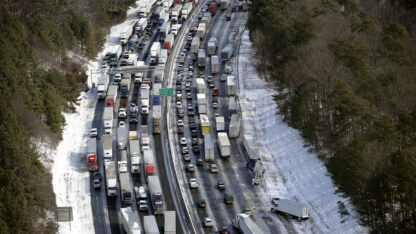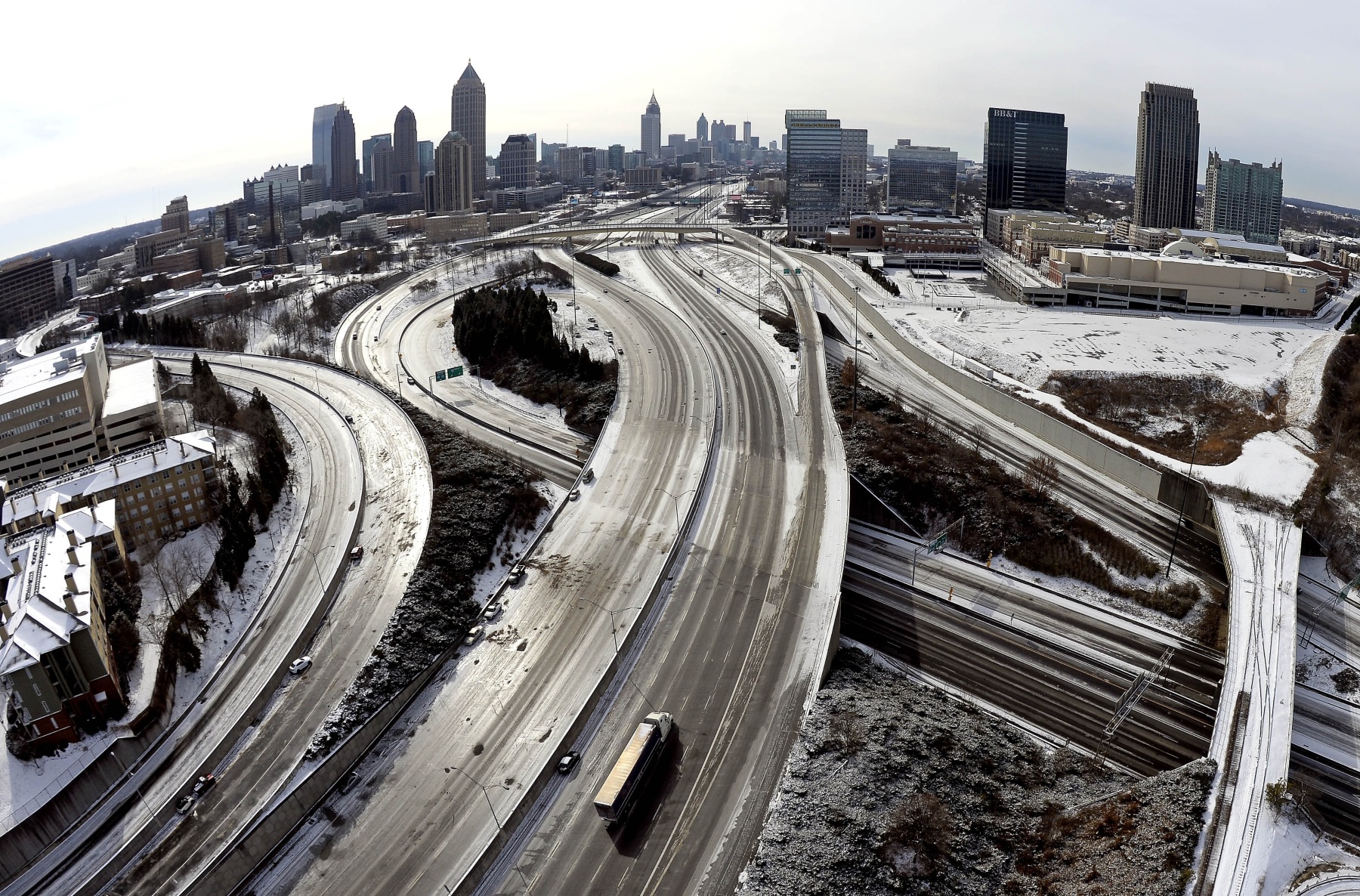Georgia is set to reconsider its air quality permitting and regulations as the U.S. Environmental Protection Agency announced on Wednesday that it is lowering limits for soot pollution known as PM 2.5.
“The science is clear. Soot pollution is one of the most dangerous forms of air pollution and it’s linked to a range of serious and potentially deadly illnesses, including asthma and heart attacks,” said EPA Administrator Michael Regan. The new rule sets the upper limit for soot pollution, lowering it from 12 to nine micrograms per cubic meter.
He said the agency estimates the new rule will avoid 4,500 premature deaths, 800,000 avoided cases of asthma symptoms and 290,000 avoided lost workdays by 2032.
Dr. Doris Brown is the former president of the National Medical Association and co-chair of the Council on Climate, Health, and Environmental Justice. She said that the worst air pollution hasn’t been distributed equally, and that movement on these limits is critical to environmental justice efforts.
“We know that communities, particularly communities of color, and vulnerable populations have long been overburdened by climate pollution because of their close proximity to sources of this dangerous and deadly pollutant.”
Air pollution in Georgia
In Georgia, researchers have already been making headway on understanding how air pollution affects community health and monitoring where the current standards and regulations haven’t been protective enough for community health.
Christina Fuller is an Associate Professor at UGA who is on the advisory group of scientists that gave recommendations to the EPA about what emissions standards would be the best to protect human health. She said the PM 2.5 regulation is movement in the right direction toward protecting communities, and aside from regulation there is still more work to be done to mitigate pollution’s reach into nearby neighborhoods.
She has been working with neighborhoods on the Westside and Southside to monitor air quality and educate neighbors on the issue.
“And it’s been very helpful for them to be able to know what’s in the air that they are breathing and also communicate with different elected officials as well with regards to what type of development will be best for their communities,” she said.
In her research, she studies ways to decrease pollution exposure for communities near transportation sources like highways and roads. Right now, she’s looking at solutions such as what kinds and density of trees along roadsides best filter soot from entering neighborhoods along with other green infrastructure solutions.
She said it may be surprising, but some kinds of trees are more effective at creating that barrier.
“Different types of pines are very good at acting like a filter: They have a lot of surface area on those pine needles in order to increase the mixing of the air and reduce particle concentrations,” Fuller said. “It’s also very important in the near roadway environment to make sure that the trees are at a specific height, and that the coverage in the canopy goes all the way to the ground.”
These solutions may seem simple, but she said they are similar to other “green infrastructure” that are being considered for reducing other environmental problems, like heat and flooding, by increasing shade and reducing paved surfaces that don’t allow floodwater to soak into the ground.
“We really have to be putting in and trying different types of solutions, such as green infrastructure, such as figuring out how to reduce air pollution, exposures and air pollution levels, so that we can become more resilient as a community,” Fuller said. “And what’s very important in making those decisions, and especially with implementing these benefits and resilient infrastructure, is to focus on those communities that are overburdened right now.”
Regulatory wiggle room
While the updated air quality standards the EPA is rolling out are being heralded as a win for environmental justice, EPA Administrator Regan also took some time in his announcement to address one of the most prominent criticisms of the new rule: That increasing stringent air quality standards may hurt the economy.
“We know that cleaner air and a strong and bustling economy go hand in hand,” Regan said. “In fact, we’ve seen it before. Since 2000, PM 2.5 concentrations in the outdoor air have decreased by 42%. While the United States gross domestic product has increased by 52%.”
Industry representatives are skeptical, and engaged in conversations and lobbying around the issue throughout the rulemaking process.
“Just because a regulation exists does not mean it must be increased,” American Road & Transportation Builders Association’s President and CEO Dave Bauer said. “Not only is EPA’s final rule unnecessary, it would also make it harder for many state and local transportation agencies to access 2021 bipartisan infrastructure law funds aimed at reducing traffic congestion and greenhouse gas emissions.”
That being said, Georgia has a lot of ways it can choose to decrease the state’s emissions. The EPA doesn’t mandate how states get their numbers down, only that they ultimately do. And according to the Georgia Environmental Protection Division’s Air Division director, Jim Boylan, decreasing emissions from individual, permitted facilities — like industrial manufacturing — is the easier part. The non-point specific sources, like traffic and transportation, are a lot harder to nail down.
There’s also another piece to the puzzle.
“Currently, if we have non-attainment areas for PM 2.5, it’s not going to be due to point sources or mobile sources, it’s going to be due to fire emissions, particularly the prescribed fire emissions,” Boylan said.
This is a tricky footnote: Prescribed burns are controlled burnings that are used in forest management to burn off dry brush that could cause large-scale forest fires. They’re a prescriptive, controlled safety measure that’s been used in Georgia all the way since Indigenous nations stewarded the land. He said the agency doesn’t want to prevent those and will be working with the state Department of Natural Resources and EPA to allow.
Ultimately, Boylan said the state has 18 months to come up with a plan for how the state will reach new air quality standards and present it to the EPA.
Looking forward to other sources
This regulation is cracking down on the smallest, and most deadly, type of air pollution, but Georgia residents still have other types of air pollution with which to contend.
Eri Saikawa is a researcher at Emory University studying air pollution and human health, looking at everything from greenhouse gases from soil related to agricultural practices to using low-cost air quality sensors to linking air quality exposure and asthma.
Currently, she is partnering with community members in South Fulton and south DeKalb County to place low-cost air quality sensors around communities that suspect they have air quality problems due to local sources. Saikawa said her project began when members of the community near an illegal landfill fire in South Fulton were concerned that the landfill’s burning was emitting harmful pollution into the air.
“The councilwoman there had already purchased the monitors,” Saikawa said, stating that she and the group then put them up around the illegal landfill site. “We didn’t necessarily measure extremely high PM values, but then I realized that PM wasn’t necessarily the only problem.”
Saikawa said there are lots of other toxic gases that come out of incineration, and that information wasn’t really available at the time. She said that in working with this community and talking with them about how they were being impacted, it was an opportunity to do more to understand the nature of the problem.
They received a grant from Emory University and are working with other neighborhoods, like neighbors in south DeKalb who are concerned about toxic gases from industrially pretreated wastewater leeching out of pipes, to assess air quality issues outside of just PM 2.5. While many of these monitoring projects are just getting started, Saikawa said communities are looking forward to gathering and understanding this data so it can be communicated to leaders in the future.









